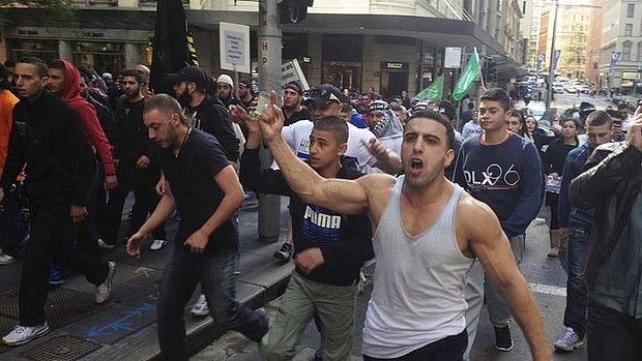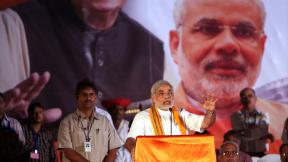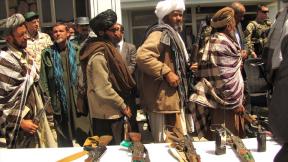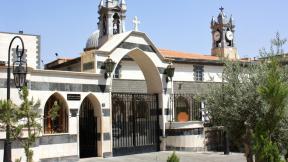
A recent PEW survey found that 19 percent of American Muslims justify violence against civilians, which translates into 55,000 to 130,000 American Muslims. Scary, isn’t it?
Unfortunately, about 51 percent of all Americans believe it is acceptable to intentionally kill civilians. That is 150 million people.
But that does not matter since the FBI is not sending out agent provocateurs among the general population. Extremists abroad and the FBI at home are targeting Muslims who might think this way, have mental issues, or low IQ levels. Both have websites to trap and engage vulnerable people. War-terrorism-Islamophobia is a nexus of evil that impacts Muslim youth in many significant ways. It is creating a high level of anger among Muslim youth, who a 2009 Gallup survey found are angrier than youth in any other faith community in the United States.
Anger is also associated with mental health issues. Forty-seven percent of college-going Muslim youth drink, some leave their faith, others develop self-hate, and others still may resort to extremist ideologies.
These are the reasons our community must not dismiss the Boston marathon bombing and Major Nidal Hasan as isolated cases.
The Boston suspects, the Tsarnaev youth, were potheads, dealing drugs at school, stealing a car, and talking girls with their Chinese carjacked captive in Boston, who managed to escape - hardly the behavior of practicing Muslims. They were reportedly angry about the Iraq and Afghan wars. They were also trying to learn about their faith through the internet and a mysterious Armenian-Russian named “Misha”, who was not a member of any mosque but claimed conversion to Islam. The elder Tsarnaev brother was thrown out of a Boston mosque when he disrupted a sermon which praised Dr. Martin Luther King Jr. All reports portray him as a young man with serious emotional and mental problems who was disconnected from a traditional Islamic education and community participation.
In this context, it is important to consider that 95 percent of all young Muslims in America are growing up with no formal Islamic education. Most do not attend full-time or weekend Islamic school. And most are not connected to Masjids or Islamic centers, the historic nucleus of the Muslim community.
Sound Vision has been concerned about the state of Muslim youth for several years now. We have thoroughly researched this topic, issued surveys and organized thinking retreats. Sound Vision has a strategic plan in place in view of the challenges Muslim youth face. We have organized 48 seminars in North America for Muslim leaders and Imams, as well as teacher training for this purpose. We were in negotiation with a major survey research organization during the last two months to research this further, when the Boston tragedy happened. If War-terrorism-Islamophobia continue, God forbid, this may not be the last time some young Muslims resort to violence behavior.
This is why the Muslim community must urgently take all steps necessary to curb extremism among young Muslims. Below are a number of suggestions.
1. Watch out for your “Misha” with dangerous, macho talk
The Uncle of the Boston suspects and the rest of their family insist it was an Olympic-grade boxer named “Misha” who radicalized them. While not much is known about this Misha, we do know some Mishas who preach extremism and violence in the community. In Chicago alone, several of these types have been chased away by community leaders by banning their attendance in the Masjid and informing the FBI about them. Despite these efforts, we have lost at least four of our community youth to these Mishas, who are now serving time in prison.
So be on the lookout for the charismatic person spouting violence and extremism at your Masjid or Islamic center. Masjids must obtain restraining orders against such individuals and report them to law enforcement, as many Imams have already done. They may really be radicalized people or agent provocateurs, since there are about 15,000 FBI informants working inside Masjids and Muslim communities. Almost all cases of terrorism since 9/11 are connected with these type of persons.
2. Don’t Allow “Harmless” Extremists to Thrive
I believe there is a correlation between “harmless” extremism and violent extremism.
No mosque to my knowledge tolerates violent talk. We never have. Not even before 9/11. However, we do ignore quite a few “harmless extremists” among us, thinking they are extremist but not violent. These are people who are religiously conservative, but do not practice faith in a respectful manner. Rather, they seek to impose their views on other Muslims.
This behavior undermines the respect for diversity in understanding and practicing Islam within the Muslim community that has existed since its inception. Our greatest scholars exercised this respect for differences in opinion centuries ago. We of lesser knowledge are obliged to follow their example. But for modern-day extremists, there is only one “correct” view on Islamic issues ranging from how to pray, to how to dress and eat.
This is why while I do not consider Niqab, women's face-veil, a requirement of Islam, I defend the right of those who observe it. My Mom wore it. Similarly, those who sport long beards or don’t let their trousers reach beyond their ankles do so because that is how they understand their faith. Others don’t feel it is necessary for men to roll up their pants above the ankles. This tolerance is the beauty of our faith, and it is guaranteed in our constitution. It must remain.
However, we don’t have to allow certain people to impose their views on the whole Masjid. Islam prohibits that. La Ikraha fid deen (no compulsion in religion, Quran 2: 256) applies among Muslims as well.
Here are some telltale signs of this kind of extremism. Many of these include macho talk and behavior, in particular, to be tolerated instead of condemned. Please note though that holding these views are not the issue per se. Rather, it is forcing others to comply to them via coercion.
- Those who do not allow women to pray in a Masjid, or those men who force women
- behind a curtain or wall in the mosque. This is something Prophet Muhammad, peace and blessings be upon him, never did.
- Those who do not allow women to speak onstage in front of a mixed-gender audience.
- Those who wage small battles against birthdays, national independence days, interfaith relations, etc.
- Those who consider democracy to be Haram.
- Those who constantly speak about, lecture, and police Islamic dress, particularly for women.
- They are also known to cut and paste their fatwas from an extremist Saudi Fatwa site.
While I will fight for these conservative Muslims’ right to practice their faith the way they understand it, forcing the whole mosque to change its policies and behavior allows a Masjid to become a potential breeding ground for terrorism. Al-Qaeda offshoots and FBI informers are seeking the ideal candidate: a person easily swayed by the loud and coercive arguments of conservatives willing to break virtually any rule to impose their views on others.
Interestingly enough, four youth arrested and sentenced for terrorist activities come from three Chicago mosques which are the most tolerant of this “soft extremism.” While it may require a master’s level thesis to establish the correlation of soft extremism and violent extremism, common sense dictates that “soft extremism” does tend to provide a targeting ground for both the recruitment of actual violent extremism as in the case of the Boston suspects and Major Nidal Hasan, or FBI agent provocateurs.
3. Develop a Plan
Most Muslim community leaders are quite concerned about Muslim youth. However, this concern normally does not translate into a plan. We propose that each community hold a thinking retreat of Muslim youth who are seniors in public schools or juniors in colleges. These 95% are the young Muslims who are neither in our Masjids, nor in Islamic schools.
How do they learn about Islam? How does negative information on the web impact them? What influences them? What is the impact of war-terrorism-Islamophobia on their personalities? How can the community help them?
They are the ones who can tell us. That thinking retreat can then provide the basis for a youth plan for your community.
4. Allocate a Budget
A priority without funding is hardly a priority. Terrorism hurts the community directly. Because 59 percent of our neighbors hold a negative opinion of Islam and Muslims, the wages of Muslims have gone down by 10 percent. Muslims are the last to be hired and the first to be fired, and 30 percent of Muslim youth hide their identity. It is important to allocate a substantial budget to achieve the plans you develop, even if it means postponing your mosque expansion and other projects. Invest in building people instead of buildings.
5. Do a Youth Program Audit
It is important to know who is teaching what at your mosque. Who teaches classes? Who is giving the Khutba? Who is hanging around the youth? Who is in charge of youth programs? What are the existing youth programs? How do the youth who attend your Islamic weekend school feel about it?
Sometimes, an extremist thrives because no one is watching. “If you see something say something” should be applied in mosques as well. If you hear anyone talking extremism, note down his name and number, and tell your Imam or Masjid president. If they are not available at the time, write a note and put it in the donation box. At times, that box is more regularly attended to than the phone.
6. Pass three resolutions at your Masjid’s general body and publicize them
It is important to clarify some positions for all attendees of Masjids:
- you need to clearly state your zero tolerance policy toward any type of extremism in the Masjid;
- you need all teachers, Khateebs, and anyone running a program in the Masjid to sign a policy statement and guidelines;
- you need a statement which articulates our responsibility toward the well-being of our community and our neighbors.
If you need sample copies of these resolutions please email us at youthhelp@soundvision.com.
7. Rethink the Masjid
It is important to create a welcoming environment for youth in the Masjid. All mosques and Islamic centers need a listening Imam. But that is not enough. We need to rethink how our Masjids work. Who will implement the plans you make for youth? If it is all left to volunteers, there is limit to their time. Ideally, each Masjid should have a youth organizer. I wonder if the local mosque could have prevented the Boston tragedy if they had had a youth program to engage Tsarnaev, instead of throwing him out when he interrupted sermons.
8. Each Masjid Should Adopt an MSA
Most youth arrested on charges of terrorism are of college age. They are mostly anti-war, and acutely aware of the tragedies of the Iraq and Afghanistan wars. If it is not possible for each Masjid to hire a full-time youth organizer, several Masjids should come together to hire a full-time Muslim Students’ Association facilitator for all of the city’s MSAs. In larger metropolitan centers, each mosque should adopt an MSA for facilitating their engagement with the community and our neighbors.
9. Address critical issues that matter for national security
Masjid khutbas, lectures in adult programs, MSA meetings and weekend schools should clearly address issues which matter in reference to national security:
- How citizens can oppose war in proper ways, and what are the wrong ways which will hurt them and their community.
- Terrorism is fasad fil Ard and Fitna, which is worse than murder in Islam (I know Muslims are sick and tired of hearing this, since most Masjids have repeatedly discussed that. But the Boston bombing suspects and their profile provide a fresh opportunity to bring up this topic.) Do share with tips.
- We must be very clear that justice in Islam is not taking one innocent life for another innocent life. Unfortunately, Dr. Yusuf Qaradawi approves of the suicide bombing of Palestinians against Israel as I myself read on his website, but has condemned it in reference to the September 11 attacks. There is no difference between the two cases except that the magnitude and impact of 9/11 was extraordinary.
Never in Islamic history has the killing of civilians been allowed. At the Prophet’s time, when there were no standing armies, he still demanded a distinction be made between combatants and non-combatants. He even compensated for the dogs killed by one of his commanders in a battle. Muslims may not follow Islamic laws that condemn killing civilians, but Islamic law has never, repeat never, been changed to allow killing noncombatants. Dr. Yusuf al-Qaradawi must revoke his Fatwa, which is often used to justify the kind of violence and terrorism that has harmed countless human beings worldwide, most of them Muslims.
In 2011, according to a Counterterrorism Center report, “Muslims continued to bear the brunt of terrorism, while attacks targeting Christians dropped nearly 45 percent from a five-year high in 2010…Muslim majority countries bore the greatest number of attacks involving 10 or more deaths, with Afghanistan sustaining the highest number (47), followed by Iraq (44), Pakistan (37), Somalia (28), and Nigeria (12).”








Add new comment